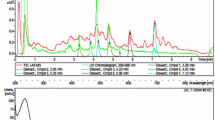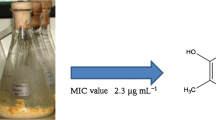Abstract
The objective of the present study was to isolate Actinobacteria, preferably Streptomyces spp. from the rhizosphere soils of three ethno-medicinal plants collected in Serbia (Papaver rhoeas, Matricaria chamomilla, and Urtica dioica) and to screen their antifungal activity against Candida spp. Overall, 103 sporulating isolates were collected from rhizosphere soil samples and determined as Streptomyces spp. Two different media and two extraction procedures were used to facilitate identification of antifungals. Overall, 412 crude cell extracts were tested against Candida albicans using disk diffusion assays, with 42% (43/103) of the strains showing the ability to produce antifungal agents. Also, extracts inhibited growth of important human pathogens: Candida krusei, Candida parapsilosis, and Candida glabrata. Based on the established degree and range of antifungal activity, nine isolates, confirmed as streptomycetes by 16S rRNA sequencing, were selected for further testing. Their ability to inhibit Candida growth in liquid culture, to inhibit biofilm formation, and to disperse pre-formed biofilms was assessed with active concentrations from 8 to 250 μg/mL. High-performance liquid chromatographic profiles of extracts derived from selected strains were recorded, revealing moderate metabolic diversity. Our results proved that rhizosphere soil of ethno-medicinal plants is a prolific source of streptomycetes, producers of potentially new antifungal compounds.





Similar content being viewed by others

References
Alimuddin A, Widada J, Asmara W, Mustofa M (2011) Antifungal production of a strain of Actinomycetes spp isolated from the rhizosphere of cajuput plant: selection and detection of exhibiting activity against tested fungi. I J Biotech 16:1–10. https://doi.org/10.22146/ijbiotech.7829
Altschul SF, Madden TL, Schäffer AA, Zhang J, Zhang Z, Miller W, Lipman DJ (1997) Gapped BLAST and PSI-BLAST: a new generation of protein database search programs. Nucleic Acids Res 25:3389–3402
Bode HB, Bethe B, Hofs R, Zeeck A (2002) Big effects from small changes: possible ways to explore nature’s chemical diversity. Chembiochem 3:619–627. https://doi.org/10.1002/1439-7633(20020703)3:7<619::AID-CBIC619>3.0.CO;2-9
Capoor MR, Nair D, Deb M, Verma PK, Srivastava L, Aggarwal P (2005) Emergence of non-albicans Candida species and antifungal resistance in a tertiary care hospital. Jpn J Infect Dis 58:344–348
Castillo U, Harper J, Strobel G, Sears J, Alesi K, Ford E, Lin J, Hunter M, Maranta M, Ge H, Yaver D, Jensen J, Porter H, Robison R, Millar D, Hess W, Condron M, Teplow D (2003) Kakadumycins, novel antibiotics from Streptomyces sp NRRL 30566, an endophyte of Grevillea pteridifolia. FEMS Microbiol Lett 29:183–190. https://doi.org/10.1016/S0378-1097(03)00426-9
Castillo U, Strobel G, Ford E, Hess W, Porter H, Jensen J, Albert H, Robison R, Condron M, Teplow D, Stevens D, Yaver D (2002) Munumbicins, wide-spectrum antibiotics produced by Streptomyces NRRL 30562, endophytic on Kennedia nigriscans. Microbiology 148:2675–2685. https://doi.org/10.1099/00221287-148-9-2675
Challis GL, Hopwood DA (2003) Synergy and contingency as driving forces for the evolution of multiple secondary metabolite production by Streptomyces species. Proc Natl Acad Sci U S A 100(Suppl 2):14555–14561. https://doi.org/10.1073/pnas.1934677100
Clinical and Laboratory Standards Institute (2008) Reference method for broth dilution antifungal susceptibility testing of yeasts—third edition: approved standard M27-A3. CLSI W, PA, USA
Clinical and Laboratory Standards Institute. (2012) Reference method for broth dilution antifungal susceptibility testing of yeasts: Fourth informational supplement M27-S4. CLSI W, PA, USA.
Cordova-Davalos LE, Escobedo-Chavezávez KG, Evangelista-Martínez Z (2017) Inhibition of Candida albicans cell growth and biofilm formation by a bioactive extract produced by soil Streptomyces strain GCAL-25. Arch Biol Sci 70:387–396. https://doi.org/10.2298/ABS170908057C
Crusemann M, O’Neill EC, Larson CB, Melnik AV, Floros DJ, da Silva RR, Jensen PR, Dorrestein PC, Moore BS (2017) Prioritizing natural product diversity in a collection of 146 bacterial strains based on growth and extraction protocols. J Nat Prod 80:588–597. https://doi.org/10.1021/acs.jnatprod.6b00722
Djokic L, Narancic T, Nikodinovic-Runic J, Savic M, Vasiljevic B (2011) Isolation and characterization of four novel Gram-positive bacteria associated with the rhizosphere of two endemorelict plants capable of degrading a broad range of aromatic substrates. Appl Microbiol Biotechnol 91:1227–1238. https://doi.org/10.1007/s00253-011-3426-9
Fguira L, Bejar S, Mellouli L (2012) Isolation and screening of Streptomyces from soil of Tunisian oases ecosystem for nonpolyenic antifungal metabolites. Afr J Biotechnol 11:7512–7519. https://doi.org/10.5897/AJB11.2180
Genilloud O (2017) Actinomycetes: still a source of novel antibiotics. Nat Prod Rep 34:1203–1232. https://doi.org/10.1039/c7np00026j
Golinska P, Wypij M, Agarkar G, Rathod D, Dahm H, Rai M (2015) Endophytic actinobacteria of medicinal plants: diversity and bioactivity. Antonie van Leeuwenhoek 108:267–289. https://doi.org/10.1007/s10482-015-0502-7
Hamid ME, Assiry MM, Joseph MR, Haimour WO, Abdelrahim IM, Al-Abed F, Fadul AN, Al-Hakami AM (2014) Candida and other yeasts of clinical importance in Aseer region, southern Saudi Arabia. Presentation of isolates from the routine laboratory setting. Saudi Med J 35:1210–1214
Hartmann A, Rothballer M, Schmid M (2008) Lorenz Hiltner, a pioneer in rhizosphere microbial ecology and soil bacteriology research. Plant Soil 312:7–14. https://doi.org/10.1007/s11104-007-9514-z
Ikeda H, Ishikawa J, Hanamoto A, Shinose M, Kikuchi H, Shiba T, Sakaki Y, Hattori M, Ōmura S (2003) Complete genome sequence and comparative analysis of the industrial microorganism Streptomyces avermitilis. Nat Biotech 21:526–531. https://doi.org/10.1038/nbt820
Ilic-Tomic T, Genčić MS, Živković MZ, Vasiljevic B, Djokic L, Nikodinovic-Runic J, Radulovic NS (2015) Structural diversity and possible functional roles of free fatty acids of the novel soil isolate Streptomyces sp. NP10. Appl Microbiol Biotechnol 99:4815–4833
Ilic S, Konstantinovic S, Todorovic Z (2005) UV/VIS analysis and antimicrobial activity of Streptomyces isolates. F U Med Biol 12:44–46
Jog R, Pandya M, Nareshkumar G, Rajkumar S (2014) Mechanism of phosphate solubilization and antifungal activity of Streptomyces spp. isolated from wheat roots and rhizosphere and their application in improving plant growth. Microbiology 160:778–788. https://doi.org/10.1099/mic.0.074146-0
Khamna S, Yokota A, Lumyong S (2009a) Actinomycetes isolated from medicinal plant rhizosphere soils: diversity and screening of antifungal compounds, indole-3-acetic acid and siderophore production. World J Microbiol Biotechnol 25:649–655. https://doi.org/10.1007/s11274-008-9933-x
Khamna S, Yokota A, Peberdy J, Lumyong S (2009b) Antifungal activity of Streptomyces spp. isolated from rhizosphere of Thai medicinal plants. Int J Integr Biol 6:143–147 http://cmuir.cmu.ac.th/jspui/handle/6653943832/5775
Kieser T, Bibb MJ, Buttner MJ, Chater KF, Hopwood DA (2000) Practical Streptomyces Genetics. John Innes Foundation, Norwich, UK.
Kostiala AAI, Kostiala I (1984) Broth dilution and disc diffusion methods in the susceptibility testing of pathogenic Candida albicans against four antimycotics. Mycopathologia 87(1–2):121–127. https://doi.org/10.1007/BF00436640
Köberl M, Schmidt R, Ramadan E, Bauer R, Berg G (2013) The microbiome of medicinal plants: diversity and importance for plant growth, quality and health. Front Microbiol 4:400. https://doi.org/10.3389/fmicb.2013.00400
Kumar D, Bhattacharyya S, Gupta P, Banerjee G, Singh M (2015) Comparative analysis of disc diffusion and E-test with broth micro-dilution for susceptibility testing of clinical Candida isolates against amphotericin B, fluconazole, voriconazole and caspofungin. J Clin Diagn Res 9(11):DC01–DC04
Kumar S, Stecher G, Tamura K (2016) MEGA7: Molecular evolutionary genetics analysis version 7.0 for bigger datasets. Mol Biol Evol 33:1870–1874. https://doi.org/10.1093/molbev/msw054
Larkin M, Blackshields G, Brown N, Chenna R, McGettigan P, McWilliam H, Valentin F, Wallace I, Wilm A, Lopez R, Thompson J, Gibson T, Higgins DG (2007) Clustal W and Clustal X version 2.0. Bioinformatics 23:2947–2948. https://doi.org/10.1093/bioinformatics/btm404
Maleki H, Dehnad A, Hanifian S, Khani S (2013) Isolation and molecula identification of Streptomyces spp. with antibacterial activity from Northwest of Iran. Bioimpacts 3:129–134. https://doi.org/10.5681/bi.2013.017
Mellouli L, Ben Ameur-Mehdi R, Sioud S, Salem M, Bejar S (2003) Isolation, purification and partial characterization of antibacterial activities produced by a newly isolated Streptomyces sp. US24 strain. Res Microbiol 154:345–352. https://doi.org/10.1016/s0923-2508(03)00077-9
Nikodinovic J, Barrow KD, Chuck JA (2003) High yield preparation of genomic DNA from Streptomyces. BioTechniques 35:932–936
Pierce CG, Uppuluri P, Tristan AR, Wormley FL Jr, Mowat E, Ramage G, Lopez-Ribot JL (2008) A simple and reproducible 96-well plate-based method for the formation of fungal biofilms and its application to antifungal susceptibility testing. Nat Protoc 3:1494–1500. https://doi.org/10.1038/nprot.2008.141
Reysenbach AL, Wickham GS, Pace NR (1994) Phylogenetic analysis of the hyperthermophilic pink filament community in Octopus Spring, Yellowstone National Park. Appl Environ Microbiol 60:2113–2119
Rios JL, Recio MC (2005) Medicinal plants and antimicrobial activity. J Ethnopharmacol 100:80–84. https://doi.org/10.1016/j.jep.2005.04.025
Schrey SD, Erkenbrack E, Früh E, Fengler S, Hommel K, Horlacher N, Schulz D, Ecke M, Kulik A, Fiedler H-P, Hampp R, Tarkka MT (2012) Production of fungal and bacterial growth modulating secondary metabolites is widespread among mycorrhiza-associated streptomycetes. BMC Microbiol 12:164–164. https://doi.org/10.1186/1471-2180-12-164
Sheir DH, Hafez MA (2017) Antibiofilm activity of Streptomyces toxytricini Fz94 against Candida albicans ATCC 10231. Microbial Biosystems 2:26–39. https://doi.org/10.21608/mb.2017.5255
Spasic J, Mandic M, Radivojevic J, Jeremic S, Vasiljevic B, Nikodinovic-Runic J, Djokic L (2018) Biocatalytic potential of Streptomyces spp. isolates from rhizosphere of plants and mycorrhizosphere of fungi. Biotechnol Appl Biochem. https://doi.org/10.1002/bab.1664
Stamenov D, Djuric S, Hajnal Jafari T, Ćirić V, Manojlovic M (2018) Microbiological activity in the soil of various agricultural crops in organic production. Contemp Agr 67:34–39. https://doi.org/10.2478/contagri-2018-0005
Stankovic N, Senerovic L, Bojic-Trbojevic Z, Vuckovic I, Vicovac L, Vasiljevic B, Nikodinovic-Runic J (2013) Didehydroroflamycoin pentaene macrolide family from Streptomyces durmitorensis MS405T: production optimization and antimicrobial activity. J Appl Microbiol 115:1297–1306. https://doi.org/10.1111/jam.12326
Thakur D, Yadav A, Gogoi BK, Bora TC (2007) Isolation and screening of Streptomyces in soil of protected forest areas from the states of Assam and Tripura, India, for antimicrobial metabolites. J Myc Méd 17:242–249. https://doi.org/10.1016/j.mycmed.2007.08.001
Vartak A, Mutalik V, Parab RR, Shanbhag P, Bhave S, Mishra PD, Mahajan GB (2014) Isolation of a new broad spectrum antifungal polyene from Streptomyces sp. MTCC 5680. Lett Appl Microbiol 58:591–596. https://doi.org/10.1111/lam.12229
Vicente MF, Basilio A, Cabello A, Peláez F (2003) Microbial natural products as a source of antifungals. Clin Microbiol Infect 9:15–32. https://doi.org/10.1046/j.1469-0691.2003.00489.x
Vos P, Garrity G, Jones D, Krieg NR, Ludwig W, Rainey FA, Schleifer K-H, Whitman W (2009) Bergey’s Manual of Systematic Bacteriology. Volume 3: The Firmicutes. Second edition. Springer-Verlag New York, New York, USA.
Waksman SA, Henrici AT (1943) The nomenclature and classification of the Actinomycetes. J Bacteriol 46:337–341
Williams ST, Mayfield CI (1971) Studies on the ecology of actinomycetes in soil III. The behaviour of neutrophilic streptomycetes in acid soil. Soil Biol Biochem 3:197–208. https://doi.org/10.1016/0038-0717(71)90015-0
Acknowledgements
PM D’Agostino would like to thank the TUM University Foundation Fellowship for funding. TAM Gulder thanks the DFG for further funding (GU 1233/1-1 and CIPSM).
Funding
This work was supported by the Ministry of Education, Science and Technological Development of Serbia (Grant No 173048) and the DAAD (Deutscher Akademischer Austauschdienst, Bilateral Project with Republic of Serbia to J Nikodinović-Runic and TAM Gulder – 2016/2017).
Author information
Authors and Affiliations
Corresponding author
Ethics declarations
This manuscript does not contain human studies or experiments using animals.
Conflict of interest
The authors declare that they have no conflict of interest.
Additional information
Publisher’s note
Springer Nature remains neutral with regard to jurisdictional claims in published maps and institutional affiliations.
Electronic supplementary material
ESM 1
(DOCX 33 kb)
Rights and permissions
About this article
Cite this article
Mojicevic, M., D’Agostino, P.M., Nikodinovic-Runic, J. et al. Antifungal potential of bacterial rhizosphere isolates associated with three ethno-medicinal plants (poppy, chamomile, and nettle). Int Microbiol 22, 343–353 (2019). https://doi.org/10.1007/s10123-019-00054-8
Received:
Revised:
Accepted:
Published:
Issue Date:
DOI: https://doi.org/10.1007/s10123-019-00054-8



